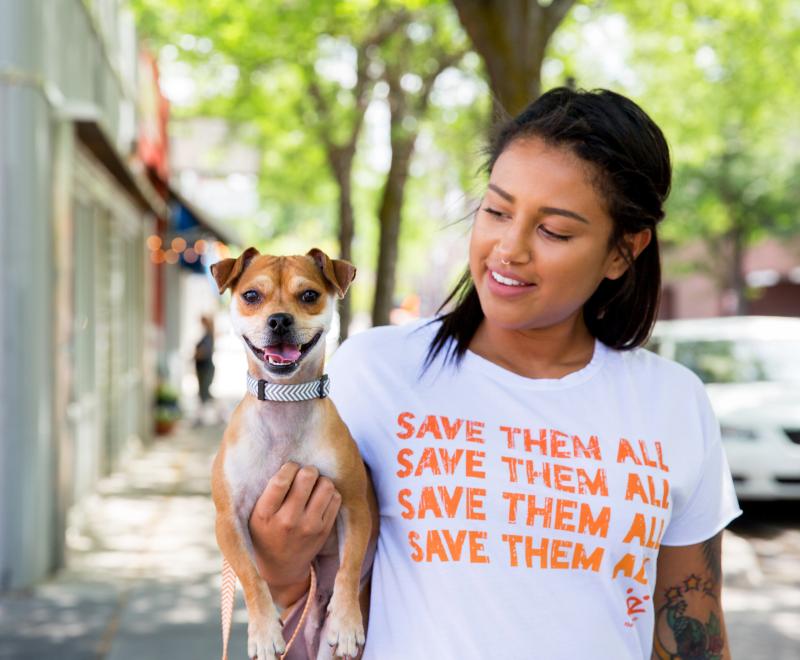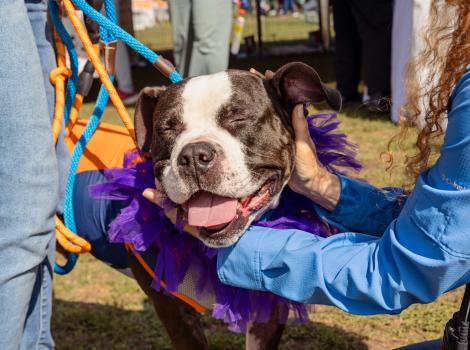No-kill 101: Keeping pets at home and out of shelters

For many years, I believed that the best place for a lost pet or a pet whom someone could no longer keep was at the local animal shelter. Like many, I assumed that shelters were safe havens where animals could find a second chance and, if not, their lives would end through what I thought was a humane process: euthanasia. But it wasn’t until I stepped into the world of animal services that I began to understand the real challenges faced by these shelters and the heartbreaking realities behind the decisions made there.
This article is part of Best Friends’ no-kill 101 series, where we discuss crucial ways that each of us can be part of ending the practice of killing pets in our local shelters. It’s to clarify what no-kill in animal sheltering is and what it isn’t. Our goal at Best Friends is for all shelters in all communities to reach no-kill in 2025, and residents in every community play a key role.
Before entering the profession of animal services, I spent over 30 years in municipal government, with 25 of those years dedicated to leadership roles in parks and recreation. One of the aspects I loved most about that work was how our programs and facilities fostered social connections and contributed to the overall wellness of the community. I found great satisfaction in creating spaces where people could come together, whether it was for a sports game, a nature walk, or simply to enjoy a day at the park.
Toward the end of my career in public service, I accepted a position as the director of our local animal shelter. It was a role that I initially took on with a great sense of duty, and quickly, I realized that animal shelters had the potential to be much more than just holding facilities for lost or homeless pets. I saw that, like parks and recreation, animal shelters could also serve as community centers — places where people could connect, learn, and contribute to the well-being of animals and, by extension, the entire community.
A sad realization
When I first took on the leadership role at the shelter, it was already changing for the better. The staff and volunteers had begun to reimagine the shelter as a safe space for pets in need, but there was still much work to be done.
One of the most eye-opening moments for me was learning about the grim reality that many shelters face: not enough space and lack of lifesaving programs. This lack of space and programming often led to the killing of dogs and cats if their families didn’t reclaim them or if they weren’t adopted within a few days.
I use the word “killing” intentionally because I came to understand that ending the life of a healthy pet, or one with a treatable medical or behavioral issue, because the shelter was full is not euthanasia. True euthanasia is an act of mercy, reserved for when an animal is suffering, not when we simply run out of room.

The beginning
In 2003, while managing a 500-acre park in a bustling urban area, we frequently encountered lost pets. My team and I made a conscious decision not to bring these lost animals to the shelter because we knew that there was a significant risk they wouldn’t make it out alive.
Instead, we reported the lost pets to the shelter, provided them with photos and details, and then took it upon ourselves to care for the animals until their families could be found. Often, this meant keeping the pet at the park for the day or finding a temporary foster home. We put up posters in the neighborhood and coordinated with the shelter, always ensuring that any pet found was reported in case their family was looking for them. We didn’t know then that we were serving as what today is called “found fosters.”
This often led to joyous reunions, with grateful people picking up their lost pets before the park closed for the day. When a reunion didn’t happen quickly, we continued to care for the animal and actively searched for their family. Over time, we even began doing adoptions ourselves, helping these pets go to new homes without ever having to set a paw in the shelter.
In addition to this, we started an informal program to trap, neuter, vaccinate, and return (TNVR) community cats, though we didn’t know it by that name at the time. Our goal was simple: prevent more kittens from being born into a life of uncertainty.
[117 cats spayed or neutered in surgery marathon]
We funded the surgeries and vet care out of our own pockets, often passing the hat among friends and colleagues to cover the costs. We found a veterinarian willing to give us a discount, and if cats weren’t claimed after a poster campaign, we either rehomed them or created a safe outdoor space where they could live.
Importantly, we also came to understand that for some cats, the outdoors was their home. They weren’t homeless but rather were community cats, cared for by multiple people on a block.

What can we do now?
These experiences profoundly shaped my understanding of how to help the animal shelter in my community. Later, as the director of the shelter, I had the opportunity to formalize these efforts. We implemented official programs like found foster and TNVR, both of which had their roots in the informal work we started during my time in parks and recreation.
Working to keep pets with their families and keeping healthy pets out of the animal shelter is now referred to as managed intake and shelter diversion. These programs are vital for any animal shelter that is prioritizing lifesaving.
[New programs help save more dogs and cats in Nebraska]
And it can be hard to rethink what we have thought to be true for years, but we have facts and data to guide us on what is best for companion animals and their people. Shelters fill up quickly, and healthy pets are killed when we're not using common sense policies and programs.
Today, there are countless ways that we can all support our local animal shelters. One of the most impactful is keeping healthy pets out of the shelter system whenever possible. By doing so, we allow shelters to use their limited space for emergencies and pets truly in need. In the end, the goal is the same: to create safe spaces where both companion animals and people can thrive, contributing to a more compassionate and connected community.
About Tawny Hammond, Best Friends director of no-kill advancement

Let's make every shelter and every community no-kill in 2025
Our goal at Best Friends is to support all animal shelters in the U.S. in reaching no-kill in 2025. No-kill means saving every dog and cat in a shelter who can be saved, accounting for community safety and good quality of life for pets.
Shelter staff can’t do it alone. Saving animals in shelters is everyone’s responsibility, and it takes support and participation from the community. No-kill is possible when we work together thoughtfully, honestly, and collaboratively.






